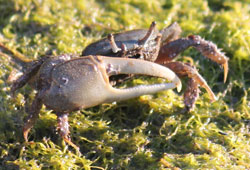Fiddler on the Roof? Northern Extension of Fiddler Crabs' Range May be Sign of Climate Change

WOODS HOLE, Mass.—David Johnson was standing in a salt marsh on the northern Massachusetts coast when he saw a fiddler crab, Uca pugnax, nearly 50 miles north of its supposed natural range. The migration north of this charismatic crab with the big, waving claw may be yet another sign of climate change. Johnson, then a scientist at the Marine Biological Laboratory (MBL) Ecosystems Center, has published his observations in the Journal of Crustacean Biology.
 An egg-bearing female fiddler crab, Uca pugnax, at Plum Island, Mass. Credit: A. Buselco-McKim.
An egg-bearing female fiddler crab, Uca pugnax, at Plum Island, Mass. Credit: A. Buselco-McKim.The fiddler crab is an attention-getting crustacean; the males have an oversized claw that they use to attract a mate and defend their territory. They can be found scuttling along beaches and marshes all along the U.S. East Coast—except, it was previously thought, north of Cape Cod, Massachusetts, which is the range limit for several warm-water marine species.
Johnson hypothesizes that warmer ocean temperatures in 2012 and 2013, which were 1.3°C higher than the previous decade’s average, allowed the crabs to move north. “Climate change is lowering the thermal barriers that kept species from moving toward the poles,” he says. Johnson’s paper documents the rapid movement of a warm-water species in the typically cold Gulf of Maine.
“When I first saw the crab, I thought, ‘You’re not supposed to be here,’” Johnson says. After the initial discovery, Johnson found the crabs as far north as Hampton, New Hampshire.
 A male fiddler crab, Uca pugnax, with oversized claw at Manchester-by-the-Sea, Mass. Credit: Jon Whitcomb
A male fiddler crab, Uca pugnax, with oversized claw at Manchester-by-the-Sea, Mass. Credit: Jon Whitcomb“In terms of climate science, the question used to be, is the climate changing? The answer is a resounding yes. The next question is, ‘How will organisms respond?’ We are now seeing that one way is by changes in where they are found,” Johnson says.
“As the world’s oceans continue to warm, we will continue to see climate-driven range expansions,” he predicts. “The next question for scientists is, ‘What is the impact of these new species on the ecosystems they move into?’”
Johnson recently joined the Virginia Institute of Marine Science as an assistant professor.
Citation:
Johnson DS (2014) Fiddler on the roof: A northern range extension for the fiddler crab Uca pugnax. Journal of Crustacean Biology 34:671-673.
—###—
The Marine Biological Laboratory (MBL) is dedicated to scientific discovery and improving the human condition through research and education in biology, biomedicine, and environmental science. Founded in Woods Hole, Massachusetts, in 1888, the MBL is a private, nonprofit institution and an affiliate of the University of Chicago.